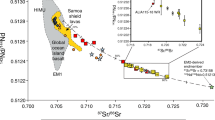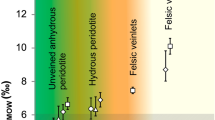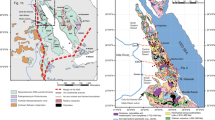Abstract
ROCKS of crustal origin metamorphosed at ultra-high pressures (P>2.5 GPa) have been described from several orogenic belts1–5. In the western Alps, for example, ultra-high pressure rocks originally equilibrated at about 750 °C and 3.5 GPa (ref. 1). During decompression, these rocks were cooled considerably and therefore did not pass through the granulite stability field. Here we describe ultra-high-pressure metasediments that have equilibrated at higher temperatures (> 1,100 °C) and followed a different exhumation path. A calcsilicate marble from the Bohemian massif contains clinopyroxenes with potassium-rich feldspar exsolutions. Potassium contents in the original clinopyroxenes indicate crystallization at pressures above 3–4 GPa (refs 6, 7). The high peak pressures and temperatures inferred for this rock, and its association with high-temperature peridotites and high-pressure granulites, suggest that carbonate sediments were subducted into the upper mantle, equilibrated at mantle conditions and were then emplaced in the crust along with mantle rocks. Our observations thus support suggestions based on less direct evidence (such as mass-balance considerations in orogenic belts8, and ocean-island basalt geochemistry9,10) that a limited amount of sediment must be recycled into the mantle.
This is a preview of subscription content, access via your institution
Access options
Subscribe to this journal
Receive 51 print issues and online access
$199.00 per year
only $3.90 per issue
Buy this article
- Purchase on Springer Link
- Instant access to full article PDF
Prices may be subject to local taxes which are calculated during checkout
Similar content being viewed by others
References
Chopin, C., Henry, C. & Michard, A. Eur. J. Miner. 3, 263–291 (1991).
Smith, D. C. Nature 310, 641–644 (1984).
Wang, X., Liou, J. G. & Mao, H. K. Geology 17, 1085–1088 (1989).
Sobolev, N. V. & Shatsky, V. S. Nature 343, 742–746 (1990).
Jagoutz, E., Shatsky, V. S. & Sobolev, N. V. EOS 71, 1707 (1990).
Erlank, A. J. & Kushiro, I. Carnegie Inst. Wash. Yb. 68, 233 (1970).
Shimizu, N. Earth planet. Sci. Lett. 11, 374–380 (1971).
Laubscher, H. Geol. Soc. Am. Bull. 100, 1313–1328 (1988).
Hawkesworth, C. J., Norry, M. J., Roddick, J. C. & Vollmer, R. Nature 280, 28–31 (1979).
White, W. M. & Hofmann, A. W. Nature 296, 821–825 (1982).
van Breemen, O. et al. Trans. R. Soc. Edinb., Earth Sci. 73, 89–108 (1982).
Wendt, J. I., Kröner, A., Todt, W., Fiala, J. & Rajlich, P. Terra Abstr. 1, 4 (1989).
Aftalion, M., Bowes, D. R. & Vrana, S. Neues Jb. Mineral. Monatshefte 145–152 (1989).
Medaris, L. G. & Carswell, D. A. in Eclogite Facies Rocks (ed. Carswell, D. A.) 260–290 (Blackie, Glasgow, 1990).
Carswell, D. A. & Jamtveit, B. Neues Jb. Miner. Abh. 162, 69–78 (1990).
Medaris, L. G., Wang, H. F., Misar, Z. & Jelinek, E. Lithos 25, 189–202 (1990).
Carswell, D. A. & O'Brien, P. J. Terra Abstr. 3, 93 (1991).
Becker, H. & Altherr, R. Geological Workshop Moravian Windows (eds Schulmann, K., Lobkowicz, M. & Melka, R.) 34 (Geological Survey, Prague, 1991).
Carswell, D. A. Eur. J. Miner. 3, 323–342 (1991).
Robinson, P. Rev. Miner. 7, 479 (1980).
Krogh, E. J. Contrib. Miner. Petrol. 99, 44–48 (1988).
Reid, A. M., Brown, R. W., Dawson, J. B., Whitfield, G. G. & Siebert, J. C. Contrib. Miner. Petrol. 58, 203–220 (1976).
Dawson, J. B. & Carswell, D. A. in Eclogite Facies Rocks (ed. Carswell, D. A.) 315–349 (Blackie, Glasgow, 1990).
Harlow, G. E. & Veblen, D. R. Science 251, 652–655 (1991).
Wood, B. J. & Holloway, J. R. Geochim. cosmochim. Acta 48, 159–176 (1984).
Gasparik, T. Contrib. Miner. Petrol. 87, 87–97 (1984).
Pearson, D. G., Davies, G. R., Nixon, P. H. & Milledge, H. J. Nature 338, 60–62 (1989).
Kornprobst, J., Piboule, M., Roden, M. & Tabit, A. J. Petrol. 31, 717–745 (1990).
Pearson, D. G., Davies, G. R., Nixon, P. H., Greenwood, P. B. & Mattey, D. P. Earth planet. Sci. Lett. 102, 289–301 (1991).
Author information
Authors and Affiliations
Rights and permissions
About this article
Cite this article
Becker, H., Altherr, R. Evidence from ultra-high-pressure marbles for recycling of sediments into the mantle. Nature 358, 745–748 (1992). https://doi.org/10.1038/358745a0
Received:
Accepted:
Issue Date:
DOI: https://doi.org/10.1038/358745a0
This article is cited by
-
Geochemistry and in-situ U-Th/Pb Geochronology of the Jambil Meta-Carbonatites, Northern Pakistan: Implications on Petrogenesis and Tectonic Evolution
Journal of Earth Science (2023)
-
Massive carbon storage in convergent margins initiated by subduction of limestone
Nature Communications (2021)
-
Recycling of Paleo-Asian Ocean carbonates and its influence on the lithospheric composition of the North China Craton
Science China Earth Sciences (2021)
-
Microstructures and Phase Transition in Omphacite: Constraints on the P-T Path of Shuanghe Eclogite (Dabie Orogen)
Journal of Earth Science (2020)
-
Deep carbon cycle in subduction zones
Science China Earth Sciences (2019)
Comments
By submitting a comment you agree to abide by our Terms and Community Guidelines. If you find something abusive or that does not comply with our terms or guidelines please flag it as inappropriate.



